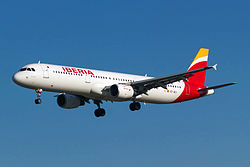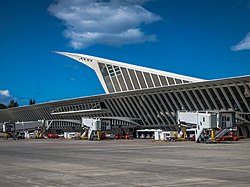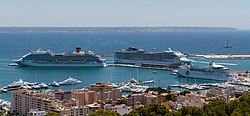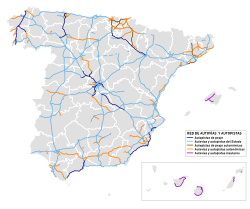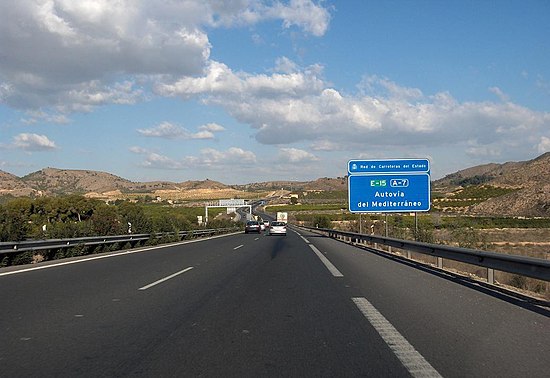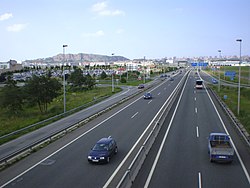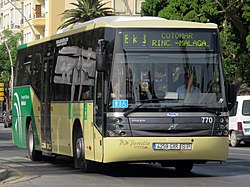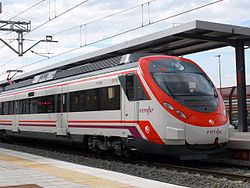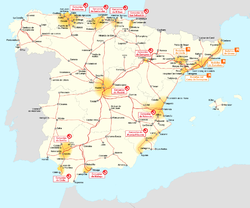Transport in Spain
The transportation in Spain is characterized by an extensive network of roads, railways and airports and ports. The country has the longest expressway network –including highways and motorways– in the European Union and the third in the world, behind only China and the United States. The rail network is characterized by a great interconnection between the different modes of transport transport -urban, metropolitan and interurban lines-, which has earned it the consideration of being one of the best countries with access to the world's trains. A benchmark in high-speed rail, it has the second most extensive high-speed network in the world, only surpassed by that of China. In air traffic there are a total of 52 airports (90% publicly managed) that mobilize more than 200 million people each year. To this is added an important network of ports on its coast, where the ports of Valencia are located (31st in container mobilization in the world) and Algeciras (32nd number).
Spain is in a strategic situation worldwide, at the southern end of Europe. Separated from Africa by one of the most frequented shipping passages in the world, the Strait of Gibraltar, which serves as a link between the Atlantic Ocean and the Mediterranean Sea and from which much of the New World maritime traffic derives. In air traffic, Spanish airports represent an obligatory link for a large part of international traffic to Latin America, Africa and the Mediterranean Arc.
Spain is considered a country with infrastructures and a complete transport network that supports its economic system. However, there is also a critical current that considers that the infrastructure policy has not been equitable, prioritizing modes of transport dedicated to the upper classes or the tourism sector, disfavoring those less wealthy sectors, such as airports and high-speed rail. compared to metro, suburban or intercity bus lines and the creation of integrated fare systems. To this we must add that not all the infrastructures built in Spain have ultimately turned out to be useful, cases of ghost airports and bankrupt toll highways The investment imbalance has also led international economic analysts to criticize that in Spain there are transport sectors where insufficient investment has been made, such as water and energy transport.
Air transportation
Air transportation is considered to be the service whose purpose is the transfer of passengers or cargo from one place to another, using an aircraft. Within the civil sphere, the air transport service can be regular and non-regular, these being offered by the airlines that operate at the airport. Airlines are characterized by being subject to itineraries, schedules and frequencies, regardless of the demand they have. Non-scheduled services are also known as charter flights. Passenger and/or cargo transportation services are provided, collectively known as the aviation industry.
The rapid development of air transport, in line with what is happening in the most advanced countries around it, is one of the most characteristic elements of the recent evolution of the Spanish transport system.
The spectacular growth in passenger air traffic in recent years, and to a lesser extent that of freight, is very illustrative. The Ministry of Public Works forecasts even higher increases for the first decade of the XXI century, which would double the figure in the short term current passenger
Airports in Spain by size of your tracks (1999 est.)
|
| ||||||||||||||||||||||||||||
Airports
Practically all of the main Spanish airports are subject to the general interest law, so their ownership is public and corresponds to the Ministry of Public Works. This task is carried out through the airport operator Aena, as well as through the public entity for the control of the national airspace, ENAIRE.
Even so, there are smaller airports that are managed by the autonomous community, such as the Castellón-Costa Azahar Airport. Some airports were closed or disabled after opening due to low traffic. Aena currently has 48 active airports with passenger traffic, to which are added another 3 managed by other operators.
In total, Spanish airports handled a total of 187,361,347 passengers in 2013. The main ones in volume of travelers were Madrid-Barajas (46,824,838), Barcelona-El Prat (39,711,237), Palma de Mallorca (23,745,023), Málaga-Costa del Sol (14,404,206), Gran Canaria (10,627.218) and Alicante-Elche (10,575,288).
Regarding merchandise, in the same year the group of 37 Spanish airports that have cargo services totaled 627,330,375 kg of merchandise transported. In this service, Madrid-Barajas (381,594,780 kg), Barcelona-El Prat (117,219,382 kg), Zaragoza (85,741,369 kg), Vitoria (46,371,874 kg), Gran Canaria (18,800,101 kg), Valencia, (13,539,904 kg), Tenerife North (12,818,854 kg) and Palma de Mallorca (11,373,639 kg).
Airlines
Airlines from many countries around the world currently operate in Spain, although most flights are usually operated by Spanish and European airlines. As for destinations, there are flights to the whole world, but the country's main connection nodes by air are the rest of Europe and Latin America. In the latter case, Spain stands out as the greatest point of connection between South America and Europe due to the strong ties of union and common commercial interests between both regions.
In 2017, Spain had 12 commercial passenger airlines. To these are added some more that carry out cargo flights, as well as private charter flight services. In that year, the commercial passenger airlines that operated in Spain were the following:
Sea transport
Spain has a wide network of ports throughout its geography, as well as various maritime transport lines for both passengers and goods, although its economic potential stands out mainly in the latter. Spain is ranked as the third power in the European Union in freight transport by port and number eleven worldwide, since it has two of the ten most important freight ports on the continent: the port of Algeciras and Valencia.
Maritime transport is the main way of importing and exporting merchandise in the country, counting in 2016 with a 74% share of the total merchandise. In this activity, the main ports in 2017 were, on the Mediterranean coast, the Port of Algeciras, the Port of Valencia and the Port of Barcelona. On the Atlantic coast, the ports with the greatest commercial activity were the Port of Bilbao and the Port of Las Palmas.
In terms of passenger transport, Spanish ports stand out for ferry transport (especially between the peninsula and the insular territories of the Balearic and Canary Islands, and between the peninsula and the Port of Melilla and the Port of Ceuta), as well as by a large influx of cruise ships and large tourist boats. The ministerial order FOM/2554/2006, of July 27, and FOM/2427/2012, of October 29, regulate discounts for maritime transport for residents of the island autonomous communities, as well as in the cities of Ceuta and Melilla.
Ports
Spain has 46 publicly owned ports protected under the general interest law. These ports are managed through 28 port authorities coordinated and managed by the state public entity Puertos del Estado, which reports directly to the Ministry of Public Works. The ports are distributed among the 30 maritime provinces into which the Spanish coast is divided.
The port with the highest passenger traffic in 2007 was Palma de Mallorca, with 5,926,000 passengers, followed by Algeciras, with 5,225,000 passengers, and Santa Cruz de Tenerife, with 4,954,000. As for cruise ships, the Port of Barcelona is the largest port in Spain in terms of cruise ships and the like (barges and other large vessels) and the fourth worldwide, followed by the port of Santa Cruz de Tenerife. Total number of passengers in Spanish ports during 2005 was 30,204,000 passengers.
In terms of merchandise, in 2007 Spanish ports moved 480,787,000 tons of merchandise. That of Algeciras was the main one, with 69,279,000 tons, followed by Valencia (53,254,000), Barcelona (50,055,000), Bilbao (38,423,000), Tarragona (35,956,000), Las Palmas de Gran Canaria (25,402,000), Cartagena (23,934,000), Huelva (21,783,000), Avilés (20,531,000), Santa Cruz de Tenerife (18,750,000), Palma de Mallorca (14,416,000), La Coruña (13,877,000), Castellón (13,087,000), Ferrol (11,039,000), Almería and Motril-Granada (9,466,000), Bahía de Cádiz (7,143,000), Málaga (6,251,000), Santander (6,187,000), Vigo (5,030,000), Seville (4,718,000), Alicante (3,598,000), Ceuta (2,082,000), Marín-Pontevedra (1,908,000) and Melilla (803,000).
Road transport
The road network in Spain is made up of the set of roads intended for mobility through the use of vehicles. They are managed in their ownership by public administrations, dividing their management between the Government of Spain (State Highway Network), the autonomous governments and the councils and town halls. In 2014, the network had a total of 1,165,361 km, of which 26,073 km are managed by the Central Administration and accommodated 50.9% of total traffic and 62.5% of heavy traffic. The different regional road networks managed 71,145 km and 43.3% of the traffic, while the councils were in charge of 68,143 km (the remaining 5.8%). In addition, the municipalities are in charge of 489,698 km of which 361,517 km are urban roads.
The entire Spanish road network is integrated into the European Highway Network, a system created by the European Union that seeks the unification and standardization of all the roads of the member countries. Thus, Spanish highways, in addition to their own name, have a second European nomenclature, which is labeled in lime green under the E-XX scheme and uniquely identifies each road within the continent's transnational system. Thus, for example, the A-62 motorway is also called E-80 within the European system.
In passenger transport, road mobility was the means most used by Spanish travelers to get around, with a great difference above the rest of means. In 2014, 90% of all passengers per kilometer traveled in Spain used some form of road transport.
Main network
Historically, the Spanish road network was created following a radial scheme with a center in the city of Madrid. This was carried out for two reasons: on the one hand, because the city holds the status of the country's capital, and on the other hand, since the city is located in the geographical center of the peninsula, communications were facilitated between all the periphery. Since the end of the XX century, population changes and economic progress in other areas have led administrations to gradually replace this model, creating new transversal roads and thus constituting a scheme in the form of a mesh.
- Motorways and motorways
The historic radial roads are called "national highways", labeled in red under the nomenclature N-XX. These have been gradually being replaced in favor of new dual carriageways and highways, labeled in blue under the nomenclature A-XX and AP-XX. Thus, many of the high-capacity roads are branching off national highways. The main network of highways and highways is part of the State Highway Network (RCE), managed by the General Directorate of Roads of the Ministry of Public Works, or in the case of being a toll highway, by the concessionary company, with according to the signed contract. In urban environments, some sections of the highways are managed by the regional governments.
- N-330 Identification and nomenclature of National Highway.
- A-97 Autovía identification and nomenclature.
As of December 31, 2015, the high-capacity road network was made up of 17,021 km, representing 10% of the total number of roads in Spain, thus making it the third country in the world after the United States and China by number of kilometers This also makes Spain the country in Europe with the longest absolute length of this type of track. The second is Germany with 12,879 km and France the third with 11,465 km.
To be considered a road as a highway or dual carriageway, it must meet the following characteristics:
- Fully care for crosses at the same level, intersections, traffic lights or roundabouts along your route.
- Minimum traffic speed of 60 km/h, except if the traffic conditions or the road situation prevent it.
- Separate roads for each sense of circulation.
- Have more than 1 lane of circulation for each direction of the march
Secondary network
The secondary road network in Spain is made up of all roads owned by the autonomous community (Autonomous Network dependent on the Autonomous Community), provincial (Provincial Network dependent on the Provincial Councils) and municipal. In 2007 there were 170,000 km of roads of this type throughout the country.
In Spain and within the scope of their respective powers, each autonomous community organizes the road network that runs through its territory (Autonomous Network, Provincial Network and Municipal Network) in accordance with their respective road laws, with the exception of the State Highway Network, which depends on the Ministry of Public Works and is governed by Law 37/2015, on State Highways.
Its nomenclature is made up of a code of one, two or three letters according to the name of the territory followed by a number. Thus, for example, the roads of the Catalan network are called C-XXX, while those of Extremadura would be identified as EX-XXX. The color code is standardized by the General Traffic Regulations. Thus, the regional motorways, like the state ones, must be labeled in blue, the first level (autonomous) roads in orange, the second level (regional) roads in green and the third level (local) roads in yellow.
- EX-A2 Identification and nomenclature of autonomic motorway. (In this case, the Extremadura Road Network)
- CA-130 Identification and autonomic road nomenclature. (In this case, the Cantabria Road Network)
- LE-232 Provincial road identification and nomenclature. (In this case, of the Provincial Highway Network of Leon)
- AL-3407 Identification and nomenclature of local road. (In this case, of the Almeria Roads Network)
Transportation by bus
- Long tour bus
Regular passenger transport lines are a regulated business of public ownership in which the different authorities allow various companies to commercially exploit the routes subject to the concession regime. The ownership of each of the lines depends on its territorial scope: The routes that pass through the interior of an Autonomous Community are granted by the autonomous government. On the other hand, those that run through more than one Community, are the responsibility of the Central Government. However, there are exceptions, with regional concessions that exceed the regional limit. Thus, each administration is in charge of designating a specific company to cover each route during the time agreed in each concession.
In 2015 there was approximately a total volume of 5,385,793,739 passengers per kilometer traveled on regular long-distance public transport lines by bus, according to data provided by the Ministry of Public Works.
Spain has a large number of bus stations. All the provincial capitals have at least one station for this type of collective transport, as well as most municipalities with more than 100,000 inhabitants. In terms of passenger volume, the operator Alsa is the company with the highest number of passengers and lines under concession in the country.
- Urban and metropolitan buses
In a large number of Spanish cities it is common to find urban bus systems that allow the urban mobility of its citizens. These services are municipally owned, although their exploitation depends on each municipality. While in some the city council is in charge of operating the public service, in other cities it is managed indirectly through concessions to private operators. The bus is the most widely used means of urban transport in all the large Spanish metropolitan areas, closely followed by metropolitan rail transport.
For their part, in the metropolitan areas, Transport Consortia have been established, which bring together the incumbent administrations and, on occasions, the operators. They are entities that assume the powers of the public bodies that make up the consortium. Some Consortiums cover the entire territory of the Autonomous Community (such as Madrid and Asturias), while in others they are limited to metropolitan areas (being the case of the Andalusian Consortiums), in such a way that the lines that exceed the metropolitan area are regional competition.
Rail transport
The Spanish railway network is the set of railways in the country. In 2015, Spain had the seventh longest European rail network, with 15,900 km built. Said network is made up of three main types of gauge: international gauge, Iberian gauge and metric gauge. The Spanish network is publicly owned and its management corresponds to different institutions: Most of the long and medium distance lines are integrated into the General Interest Railway Network (RFIG), owned by the Ministry of Public Works and managed through Adif. Likewise, there are certain sections owned by the different regional governments, as well as metropolitan or local railway lines that are owned by the corresponding municipalities.
Until the 1990s, the Spanish rail network was largely Iberian gauge (1,668 mm). This has traditionally been an obstacle to the development and efficiency of the railway in the country, especially for the transport of goods, due to the difference in gauge with France and other European countries. With the construction of the Madrid high-speed line -Seville decided to adopt the standard gauge for the first time (1,435 mm), which has been used since then on almost all high-speed tracks developed up to then.
Renfe Operadora is a public railway operator dependent on the Ministry of Public Works. It is the most important passenger transport company in the country with a license to commercially operate Adif's General Interest Railway Network. Renfe offers regular long, medium and short distance services, both high speed and conventional speed. In freight transport there are nine other private companies in addition to Renfe Mercancías, a subsidiary of the public operator.
- Road widths
Currently, up to 6 different gauges coexist on the Spanish rail network. This goes back to the origins of the railway in the Iberian Peninsula in 1844, in which several engineers prepared a report, known as the Subercasse report, for the feasibility of its construction. It recommended that the track gauge be 6 Castilian feet (approximately 1,672 mm). This would make it possible to have steam locomotives with a larger boiler that had enough power to face the difficult Spanish orography.
Although after a short time the reasoning about the power of the locomotives was ruled out as valid and in most European railways the standard 1,435 mm was already established, the General Railway Law of 1855 maintained the measure, however, this width ended up only being applied to Line 1 of the Barcelona Metro. In 1955 an agreement was signed between RENFE and Caminhos de Ferro Portugueses to establish the Iberian gauge at 1,668mm. This decision ended up proving to be an error that has historically hampered the international expansion of the railway in Spain and has reduced the capacity of the train to transport goods between the peninsula and the rest of Europe.
In the last decade of the XX century, the standard gauge was introduced in Spain starting with the High Speed line to Seville (N.A.F.A., inaugurated in 1992), and this width was adopted for all similar lines to be made in the future. However, this plan acquired a much more ambitious dimension at the beginning of the eighth legislature in 2005, when the Ministry of Public Works prepared a study, called the Strategic Infrastructure and Transport Plan, with which it was intended to lay the foundations for the adaptation of the entire conventional network. national standard width, without exclusion of any autonomous community.
With these measures, the Government of Spain seeks to ensure interoperability with the rest of the European rail network and increase the transport of goods with the countries of the continent. However, given the magnitude of the disbursement that the application of these measures supposes for the public treasury, it is estimated that the transformation of the network will only be possible in the long term.
High Speed Lines
High speed in Spain is made up of five main high speed corridors and multiple lines that connect to them. All of them in turn are integrated into their respective European corridors, integrated into the basic network of the Trans-European Transport Network (TEN-T). Practically all of the high-speed network (as well as all the lines planned or under construction) are standard gauge. With 3,410 km in service, it is the longest high-speed network in Europe and the second in the world, only behind China.
All high-speed lines are included in the General Interest Network and are managed by Adif Alta Velocidad, a public business entity of the Ministry of Public Works in charge of managing these lines. None of the corridors is completely finished: all of them have part of the lines that form it in service or under construction. All of them are listed below:
- Mediterranean Corridor: Its route connects the French border in Figueres-Vilafant with Algeciras in parallel to the Mediterranean coast. It covers the autonomous communities of Catalonia, the Valencian Community, the Region of Murcia and Andalusia.
- Central Corridor: It also connects the French border with Algeciras, running through the communities of Catalonia, Aragon, Madrid, Castilla-La Mancha and Andalusia.
- Atlantic Corridor: Its objective is to unite the Atlantic front with the interior (Madrid) and the rest of Europe. It is not a linear corridor, but rather its shape resembles a star, because its purpose is to unite numerous ports of the Atlantic facade both with Madrid and the French border through the passage of Irún.
- Cantabrian-Mediterranean Corridor: Its objective is to unite the Cantabrian Coast and the Spanish Lift. Once completed, it will cover the cities of Valencia, Teruel, Zaragoza, Tudela, Logroño, Miranda de Ebro, Pamplona and Santander.
- Atlantic-Mediterranean Corridor: Its objective is to connect the Atlantic Peninsular facade (Including Portugal) with the central corridor and the Mediterranean.
Renfe is the main operator authorized to operate high speed in Spain. The public operator offers its high-speed services through three different brands: Alvia, Avant and AVE. International routes with France are operated by Renfe-SNCF in Cooperation, a joint venture created in equal parts by Renfe and SNCF.
AVE (Spanish High Speed) is Renfe's most popular brand. Under this name, the company offers its high-speed long-distance services (up to 300 km/h). High-speed services at reduced cost are operated under the Renfe Avlo brand.
The Alvia are mixed services capable of traveling on conventional and high-speed roads at the same time and are used to shorten travel times on routes that do not yet have roads of this type throughout the route. Avant is the name given to Renfe's medium-distance, high-speed services.
In 2020, as a consequence of the liberalization of passenger transport, two new competitors that operate some of the main high-speed routes entered the market: Ouigo (SNCF subsidiary) and Iryo (Trenitalia subsidiary).
Conventional lines
Adif refers to all those sections of the General Interest Network that are not suitable for high speed as conventional lines. Of these, 10,509.7 kilometers are of Iberian gauge and 118 of mixed gauge (combination of Iberian and standard gauge). The main lines of this set generally admit speeds between 160 and 220 km/h. Most of the lines are integrated into the Trans-European Conventional Rail Network.
In addition to the RDIG, there are lines of autonomous ownership or private derivations. This includes all the broad gauge lines with the exception of the Barcelona-Vallés and Lleida-Puebla de Segur lines, of a regional nature and belonging to FGC, and all the narrow gauge lines with the exception of those transferred to Catalonia, the Basque Country, the Valencian Community and the Balearic Islands.
In passenger services, Renfe is the main rail operator of this network with daytime long-distance services under the Intercity and Euromed brands and nighttime services under the Trenhotel brand. In freight, both Renfe Mercancías and its subsidiaries as well as other private operators work in this network.
Renfe also, together with Comboios de Portugal, the Lusitania night line, which connects the cities of Lisbon and Madrid.
Community hubs
Renfe Regional
Commuter trains are a form of public rail transport with high capacity and frequency, aimed at metropolitan areas and with regular schedules. Most of the lines are provided by Renfe, through one of its two divisions dedicated to this purpose: Renfe Cercanías and Renfe Cercanías AM. In certain nuclei, these services are provided jointly by autonomously owned railway operators.
The main suburban services of Renfe Cercanías usually run on conventional tracks of Iberian gauge, which in many cases they share with the rest of the trains, at any time of the day. These services are provided both in stations shared with other types of services and in specific ones.
Currently, Renfe Cercanías operates 12 hubs throughout the country, the largest being those in Catalonia (462.7 km) and Madrid (370 km).
Although a good part of the railway lines that today form part of Cercanías already existed since the 1850s, its origin as an integrated and coordinated network occurred in 1980, when the “Plan Ferroviario de Cercanías” was approved.. Its objective was to remodel the existing rail services and create other new services around the main cities, creating a modern metropolitan transport and encouraging the use of the train over the private vehicle for daily trips.
Regarding rolling stock, Renfe uses railways specially designed for this type of service. These are characterized by having a large number of doors, wider and double leaf. The interior space is diaphanous, prepared to accommodate a large number of travelers standing and with no space specially dedicated to luggage. The most recent ones are more accessible for people with reduced mobility and their finishes are usually made with harder and more resistant materials than conventional trains. The models currently in use are the 442, 446, 447, 450, 451, 592 and Civia series.
Regional trains
The objective of the regional train services is to communicate most of the municipalities that have railways with their provincial and regional capital, within a maximum radius of action of 300 km in general.
Most of the regional lines in Spain are operated by Renfe, through the Renfe Media Distancia and Renfe Avant brands. The latter is used to name regional high-speed services. There are Media Distance services in all Spanish provinces, with the exception of island territories.
Media Distancia services run entirely on conventional roads, both electrified at 3000 volts DC and without electrification. The material used in these lines is very diverse: 440, 470, 448, 592, 596, 594, 449, 598, 599 and 490. Line 3 uses a UT 592 from Comboios de Portugal.
In the autonomous communities of the Basque Country and Catalonia, this network is complemented by other autonomously owned lines, while in the case of Palma de Mallorca, the autonomous operator SFM is the only one with a presence in the province.
Regional at high speed
High-speed regional trains in Spain date back to 1992, when the Madrid-Seville AVE line was inaugurated. At that time, RENFE had ordered 24 units of the 100 Series, designed to run on standard gauge, which at that time was underused. As a provisional solution, it was decided to implement a regional service called "AVE Lanzadera", managed by the High Speed Business Unit. The measure, against all odds, was a resounding success: In 1995 it had exceeded one million passengers per year.
It was a fast Media Distancia service, at an affordable price, and more flexible than the AVE. The success was such that several studies even showed how it contributed in a very important way to the economic development of cities such as Ciudad Real. As of January 1, 2005, Renfe Operadora began to use the first Series 104 units for these services. For its part, commercial management became more rigid, with the introduction of mandatory reservations in a voucher system of 20 to 50 trips per month.
In 2006 it was decided to transfer these services to the Media Distancia business unit, since these lines, being under the framework of the obligatory public service, can receive subsidies, contrary to those of Long Distance, which ceased to be able to receive them in 2010. A year later, and as a consequence of the fact that the use of the AVE brand for regional trains could be confusing for users, they were renamed under the brand Renfe Avant.
In 2020 there are twelve Avant lines, which serve the autonomous communities of Andalusia, Aragon, Catalonia, Castilla-La Mancha, Castilla y León and Galicia. These lines are made up of models from the 104, 114 and 121 series, all of which can reach up to 250 km/h.
Metric gauge railway
Although the predominant track gauges in Spain are Iberian and international, there are some sections in metric gauge (1000 mm), with a special presence in the north of the country.
After the creation of RENFE in 1941, the trains left in the hands of Explotación de Ferrocarriles por el Estado (“Explotación de Ferrocarriles por el Estado”) was greatly reduced, as it was limited to narrow-gauge railways. The situation changed radically after 1960, when a large number of small mining railways went bankrupt and the State had to take over. As a consequence of this, on September 23, 1965, the creation of a new autonomous body was formalized; and that same day EFE changed its name to Ferrocarriles Españoles de Vía Estrecha (FEVE).
After the approval of the 1978 Constitution, and in accordance with the status of the autonomies that it establishes, from 1979 a significant part of the narrow gauge network was transferred by the central government to the new autonomous communities, the what was the germ of these autonomous public operators.
FEVE specialized in the regional transport of passengers and goods on the Cantabrian coast: In Asturias and Cantabria, it had an important network of commuter lines. In Galicia, the commuter line between Ferrol and Ortigueira operated. In addition, it also had a line between Cartagena and Los Nietos in the Region of Murcia.
On July 20, 2012, in order to optimize state railway resources, FEVE was extinguished. Its functions were subrogated to Adif, which acquired the infrastructure and stations, and to Renfe, which acquired the rolling stock and exploitation rights. Thus, the national wide-gauge and narrow-gauge networks of state ownership were unified throughout the country.
Until 2021, Renfe continued to use the brand of its predecessor under the name "Renfe Feve". As of that date, and as part of the progressive integration of these services into Renfe Cercanías that the operator had been carrying out, the commercial name of the service was changed to "Renfe Cercanías AM", accompanied by the characteristic red symbol that was already used for the main short-distance rail network.
Currently, Renfe Cercanías AM has six nuclei, being Asturias the one with the largest number of users and lines. On the other hand, the lines with the most traffic are those corresponding to Cantabria, with close to 2 million users each.
Autonomous railways
In addition to the regional nuclei operated by Renfe, in four communities there are also other railway operators whose ownership is held by their corresponding regional governments: Catalonia, the Basque Country, the Valencian Community and the Balearic Islands.
- Euskotrena is a railway operator owned by the Basque Government that operates nearby, regional and subway lines in the provinces of Vizcaya and Guipúzcoa. It began its activity in 1982, following the transfer to the Basque Autonomous Executive, by the State, of several railway tracks of metric pathways that were carried out entirely in Basque territory, under its new statute of autonomy.
- FGC is a railway company owned by the Generality of Catalonia, which operates several railway corridors in the four Catalan provinces. In total, the company operates 140 km of narrow road, 42 km of international route in the province of Barcelona and 89 km of Iberian width, two zipper trains and several funiculars.
- FGV is a public company dependent on the Valencian government responsible for managing and managing the metric-wide railway lines that extend through the management of the Valencia metro and the metropolitan tram of Alicante. Its network has a total length of 285,53 kilometers and 211 stations.
- SFM is a railway operator owned by the Government of the Balearic Islands founded in 1994. It is responsible for the exploitation of the railway lines of narrow and subway of the island of Mallorca, with the exception of the line Palma-Sóller. The length of lines operated by this company is 85 km, corresponding 70 km to the regional lines, 8 km to the Metro de Palma and 7 km mixed.
Transportation of goods
The transport of goods by rail in Spain has had a historically low market share. In Spain, only 5% of the goods transported by land circulate by rail, compared to 95% by road. This represents a share that is significantly lower than the 18% average in the European Union.
One of the historical problems that have weighed down this market in Spain has been the different gauge that has traditionally existed with respect to France and the rest of Europe or the lack of investment in infrastructure or the difficulty of accessing the companies that compete with Renfe for rolling stock.
A report by the National Markets and Competition Commission pointed out as one of the main factors the need for better connectivity between ports and railway stations, since both are closely related. The solution to this is part of the completion of the railway corridors, especially the Atlantic and the Mediterranean.
The state operator Renfe has a division specialized in this sector, Renfe Mercancías. Since the liberalization of the freight rail sector in 2011, together with it there are eight more private operators: Acciona Rail Services, Comsa Rail Transport, Continental Rail, Ferrovial Railway, Logitren Ferroviaria, Traccion Rail, Transfesa Rail and Transitia Rail.
In 2015, the Spanish freight rail market had a turnover of 304.2 million euros, which represents 12% of the total revenue of the sector.
Urban and metropolitan railway
In addition to long and medium distance railways, a large part of the large urban centers in Spain have metropolitan and urban railway networks. These are urban public passenger transport systems whose objective is to connect different points of the same city and unite it with its metropolitan area.
Combining the metro and tram systems, the country has some twenty networks distributed throughout 16 provinces. The ownership of these means of transport rests with the regional or municipal government of each zone and, with some exceptions, they have their own railway infrastructure independent of the network of general state interest.
Subway
Spain has nine cities in which there are metro networks. It is a means of transport with high frequency and capacity. According to data from the National Institute of Statistics, this means of transport concentrates more than 100 million trips per month throughout the country.
Most of the Spanish metro systems have suburban services and also light rail. This modality presents characteristics comparable to those of a traditional metro, but using rolling stock similar to that of trams. Some examples are line 11 of the Barcelona Metro or line 6 of the Valencia Metro. In the case of the networks of Seville, Malaga and Granada, all the infrastructure is of this type.
The Madrid Metro, inaugurated on October 17, 1919 by King Alfonso XIII, is the oldest in Spain. At that time it had a single line, which covered three and a half kilometers divided into eight stations. Its success was resounding, with 14 million trips in its first year of life. Since then, its growth has led it to become the most extensive network in Spain and the ninth in the world, with 293 kilometers in service.
Six years later, on December 31, 1924, the Barcelona Metro was inaugurated in an act presided over by the Infante Ferdinand of Baviera on behalf of the King. Back then it was a single line called Gran Metropolitano. It consisted of 2.7 kilometers between the stations of Plaza de Cataluña and Lesseps. In 1926 the second line was put into operation, extending the extension of the metro to 8 kilometers. That same year, a new four-kilometre railway line was inaugurated, which was called "El Transversal". The unification of the system came in 1952, when the Barcelona City Council ordered the municipalization of all public transport companies in the city. Since then this system has undergone a notable expansion, adding up to 170 kilometers spread over 12 lines.
After the approval of the 1978 Constitution and the establishment of the autonomous communities, the popularization of this transport system led to the creation of new nuclei in other cities. The third was the Valencia metro (1988), which had as its seed the narrow gauge infrastructures operated by FEVE and which were later transferred to the regional government. It is currently the third largest network in the country, with 156 kilometers divided into ten lines.
On November 11, 1995, Bilbao launched the fourth metro network in the country. The Bilbao metro initially consisted of a single line, operated by a company dependent on the Vizcaya Transport Consortium. This line was gradually expanded and a second was added to it in 2002. In 2017 the third line was added, operated by Euskotren Trena.
The Palma de Mallorca metro, inaugurated in 2007, was the first island metro network to be built. It is owned by the Government of the Balearic Islands, which manages it through the public operator SFM, which is also in charge of operating commuter services on the island.
Andalusia is the autonomous community with the largest number of metropolitan train networks. In the 2010s, the Andalusian government carried out an urban railway expansion plan that culminated in the creation of the Seville metro (2009), the Malaga metro (2014), the Granada metro (2017) and the Trambahía of Cádiz (2022).
Tram
Throughout the XX century, Spain had an extensive network of trams in the main cities of the country. The first line, animal-drawn, circulated through Madrid in 1871. Barcelona and Bilbao followed a year later. The popularization of this means of transport, which revolutionized urban mobility at the time, led to the implementation of tram networks in some twenty cities.
The first steam tram arrived in Barcelona in 1877. It was followed by the Madrid-Leganés Tram in 1879 and the Valencia Tram in 1892. The first city to introduce the electric tram service was Bilbao, with the Bilbao-Santurce line, electrified in 1896 and managed by a predecessor of the current Collective Transport.
However, urban changes during the 1960s and 1970s, as well as the popularization of the private vehicle, led to the decline of the tram as a means of transportation. During these decades, most cities dismantled their tram networks, citing reasons of traffic jams or their propensity for accidents.
Buses gradually replaced the railway as a means of public transport until they practically disappeared. The last tramway network to be dismantled was that of Zaragoza in 1975. Only the Tibidabo tramway (Tramvia Blau) and the Sóller tramway in Majorca remained as tourist attractions.
The return of the tram to Spain came thirty years later. On May 21, 1994, line 4 of MetroValencia was inaugurated, which recovered this means of transport with notable success. The first modern tram network arrived in 1999 with the inauguration of the Alicante Metropolitan Tram.
Changes in urban mobility paradigms led other cities to consider the tramway as a sustainable and efficient alternative for mass passenger transport. Its popularization led to the inauguration of the tramways in Bilbao (2002), Barcelona (2004), Madrid (2007), Seville (2007), Santa Cruz de Tenerife (2007), Vitoria (2008), Murcia (2011), Zaragoza (2011) and Cádiz (2022). The Jaén tram is pending inauguration.
The trams that we find today in Spain are an update of the original concept. This type of transport —commonly known as modern tram— uses low-floor rolling stock, which is wider and has greater capacity, which significantly improves its safety, comfort and speed. In addition, in a good part of them, the tramway platform is physically segregated from the rest of the traffic, with technical characteristics almost comparable to those of the light rail.
The Trambahía de Cádiz is a particular case, since it is the only train-tram in Spain. This project, owned by the Andalusian government and operated by Renfe, is a hybrid model between a modern tram and a commuter train. This line behaves like a modern tram in the municipalities of Cádiz, San Fernando and Chiclana de la Frontera to later join the Cercanías network —using the Adif infrastructure— to the stations of Puerto Real, El Puerto de Santa María and Jerez de la Frontera.
Funicular Railway
The funicular is a special type of railway used to cross large slopes. The history of these in Spain begins with the Tibidabo funicular in Barcelona, the oldest of all of them and still in service. There are currently twelve of these throughout the country.
In the year 1900, the need to provide transportation that would allow access to the projected Tibidabo Amusement Park required a means of transportation that was capable of bridging the 275-meter drop between Avenida del Tibidabo and the mountain. It was decided that the best option was to build a funicular that was inaugurated a year later, on October 29, 1901. In 2019, a major reform of all its infrastructure was undertaken, which culminated in its reopening in 2021. Six years later, the from Vallvidrera. In 1921, on the occasion of the Barcelona Universal Exposition, the third in the province was launched, the Montjuic Funicular. Currently, the Catalan capital has three more funiculars: Gelida and Sant Joan and La Santa Cova, in Montserrat.
After Catalonia, the community with the second largest number of funiculars is the Basque Country: In Bilbao we find the Archanda funicular, operated by the city council and whose objective is to connect the city with the mountain of the same name. The shuttle to Mamariga is also a funicular, which is integrated into line 2 of the Bilbao metro and connects this neighborhood with the Santurce station. In Vizcaya is located the Larreineta funicular, inaugurated in 1924 to access a mining area. It was declared an Asset of Cultural Interest in 2014 for its peculiar horizontal platform. In Guipúzcoa, as in Tibidabo, the Igueldo funicular was built in order to access the amusement park located on top of the mountain.
In 2001, the Bulnes funicular was launched in Asturias, connecting the villages of Poncebo and Bulnes, both in the Picos de Europa. The most recent is the Río de la Pila funicular, in Santander; It was inaugurated in 2008 with the aim of saving the steep slope located to the south of the General Dávila promenade, traveling 78 meters along four stops.
Cog railway
The rack railway is a particular type of railway that bases its operation on the mechanical coupling to the track by means of a third toothed rail. Spain has two means of transport of this type, both in Catalonia.
- Montserrat Cremallera (Monistrol de Montserrat)
- Nuria Cremallera (Ribas de Freser-Queralbs)
The Montserrat rack railway was inaugurated on October 6, 1892 by the company “Ferrocarriles de Montaña a Grandes Pendientes”. The journey, which at that time lasted an hour, was a revolution for the time, as it allowed going to and from Montserrat from Barcelona in a single day. The outbreak of the Civil War paralyzed its operation and significantly deteriorated its facilities. Although later attempts were made to reactivate it, a serious accident in 1953 led to the closure of the line. Decades later, the Generalitat considered building a rack railway to Montserrat again. The project finished its works in 2001 and was inaugurated in 2003, operated by FGC.
The origins of the Nuria rack railway date back to the beginning of the XX century. At that time, the Queralbs Sanctuary experienced an increase in visitors. The only way to get there involved a 1-3 hour walk, so the FMPG company (Ferrocarrils de Muntanya de Grans Pendents) proposed a rack railway to facilitate access. The line was inaugurated on March 22, 1931, with electric trains since its creation. With the passage of time, the line suffered significant deterioration in its facilities, and the delicate situation of the responsible company did not allow for further improvements. The increase in tourism to the Núria Valley, especially by people who practiced snow sports, encouraged the institutions to want to recover this railway. In 1982 the Catalan government decided to rescue the company, becoming its owner. From that moment on, a plan was carried out to renew the rolling stock, catenary and tracks that culminated in its reopening in 1985 by FGC.
Cable Car
The cable car is an air transport system made up of cabins hung from a series of cables that are responsible for moving the units through the stations. Spain has seven cable cars currently in operation. Most of these, in addition to serving as a means of transportation, are used as tourist attractions.
The first cable car as this means of transport is known today is that of Montserrat. It was inaugurated on May 17, 1930 after two years of construction. It is 1,300 meters long, saving a drop of 544 meters.
The city of Barcelona has the most cable cars in Spain, with two in operation: the Cable Car of the port and the one of Montjuic. The first was inaugurated in 1930 with the aim of connecting the Port of Barcelona with the Miramar gardens. The second was inaugurated in 1970 with the aim of reaching the mountain and the castle that is located at the top of Montjuic.
The Fuente Dé cable car was the third to be inaugurated, on August 21, 1966. It is located in the Liébana region (Cantabria), in the heart of the Picos de Europa. The views it offers at an altitude of 1,800 meters are one of the greatest tourist attractions in the area.
The Madrid cable car was inaugurated in 1969. Its route flies over the Parque del Oeste rose garden, the Príncipe Pío commuter station, the San Antonio de la Florida hermitage and the Manzanares river and ends next to the Plaza de los Lost Steps of the Country House. The City Council municipalized its exploitation in 2018, since then it has been managed by the EMT.
The Teide cable car is the highest in the country, since its highest point is only 160 meters from the top of this mountain. It was inaugurated in 1971 and underwent a major renovation of its facilities in 2007. For its part, the Benalmádena cable car, inaugurated in the year 2000, is the one with the longest route in the country. Its main function is its tourist attraction due to the panoramic views it offers of the Costa del Sol along its route that connects the town of Arroyo de la Miel with Mount Calamorro.
Contenido relacionado
Windows Me
AZF
Perforated card




